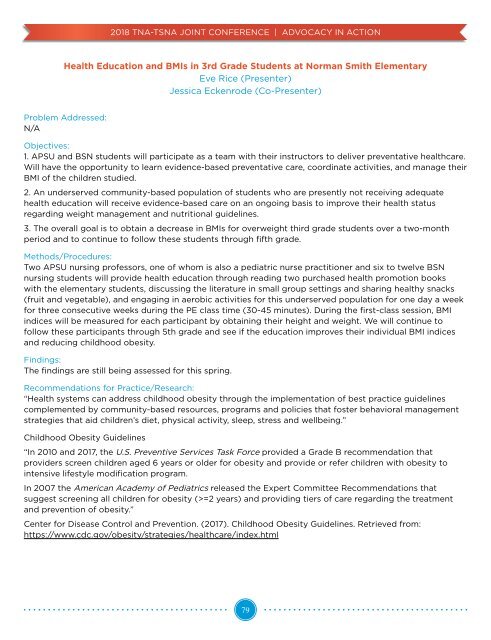2018 TNA and TSNA Joint Annual Conference
You also want an ePaper? Increase the reach of your titles
YUMPU automatically turns print PDFs into web optimized ePapers that Google loves.
<strong>2018</strong> <strong>TNA</strong>-<strong>TSNA</strong> JOINT CONFERENCE | ADVOCACY IN ACTION<br />
Health Education <strong>and</strong> BMIs in 3rd Grade Students at Norman Smith Elementary<br />
Eve Rice (Presenter)<br />
Jessica Eckenrode (Co-Presenter)<br />
Problem Addressed:<br />
N/A<br />
Objectives:<br />
1. APSU <strong>and</strong> BSN students will participate as a team with their instructors to deliver preventative healthcare.<br />
Will have the opportunity to learn evidence-based preventative care, coordinate activities, <strong>and</strong> manage their<br />
BMI of the children studied.<br />
2. An underserved community-based population of students who are presently not receiving adequate<br />
health education will receive evidence-based care on an ongoing basis to improve their health status<br />
regarding weight management <strong>and</strong> nutritional guidelines.<br />
3. The overall goal is to obtain a decrease in BMIs for overweight third grade students over a two-month<br />
period <strong>and</strong> to continue to follow these students through fifth grade.<br />
Methods/Procedures:<br />
Two APSU nursing professors, one of whom is also a pediatric nurse practitioner <strong>and</strong> six to twelve BSN<br />
nursing students will provide health education through reading two purchased health promotion books<br />
with the elementary students, discussing the literature in small group settings <strong>and</strong> sharing healthy snacks<br />
(fruit <strong>and</strong> vegetable), <strong>and</strong> engaging in aerobic activities for this underserved population for one day a week<br />
for three consecutive weeks during the PE class time (30-45 minutes). During the first-class session, BMI<br />
indices will be measured for each participant by obtaining their height <strong>and</strong> weight. We will continue to<br />
follow these participants through 5th grade <strong>and</strong> see if the education improves their individual BMI indices<br />
<strong>and</strong> reducing childhood obesity.<br />
Findings:<br />
The findings are still being assessed for this spring.<br />
Recommendations for Practice/Research:<br />
“Health systems can address childhood obesity through the implementation of best practice guidelines<br />
complemented by community-based resources, programs <strong>and</strong> policies that foster behavioral management<br />
strategies that aid children’s diet, physical activity, sleep, stress <strong>and</strong> wellbeing.”<br />
Childhood Obesity Guidelines<br />
“In 2010 <strong>and</strong> 2017, the U.S. Preventive Services Task Force provided a Grade B recommendation that<br />
providers screen children aged 6 years or older for obesity <strong>and</strong> provide or refer children with obesity to<br />
intensive lifestyle modification program.<br />
In 2007 the American Academy of Pediatrics released the Expert Committee Recommendations that<br />
suggest screening all children for obesity (>=2 years) <strong>and</strong> providing tiers of care regarding the treatment<br />
<strong>and</strong> prevention of obesity.”<br />
Center for Disease Control <strong>and</strong> Prevention. (2017). Childhood Obesity Guidelines. Retrieved from:<br />
https://www.cdc.gov/obesity/strategies/healthcare/index.html<br />
79

















